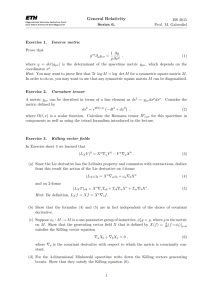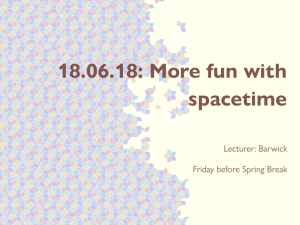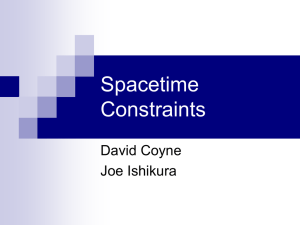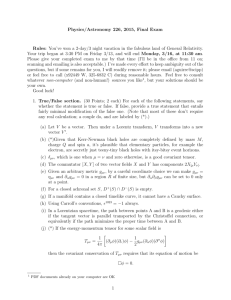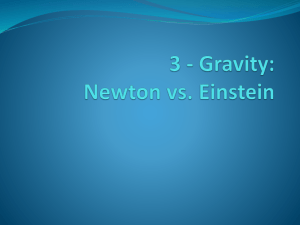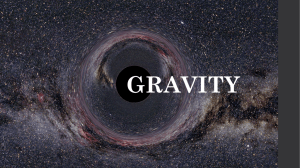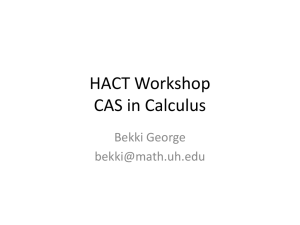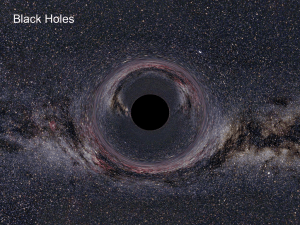Special and General Relativity Lecture Notes: Day 10 (10/07/08) Contents Shawn Mitryk
advertisement
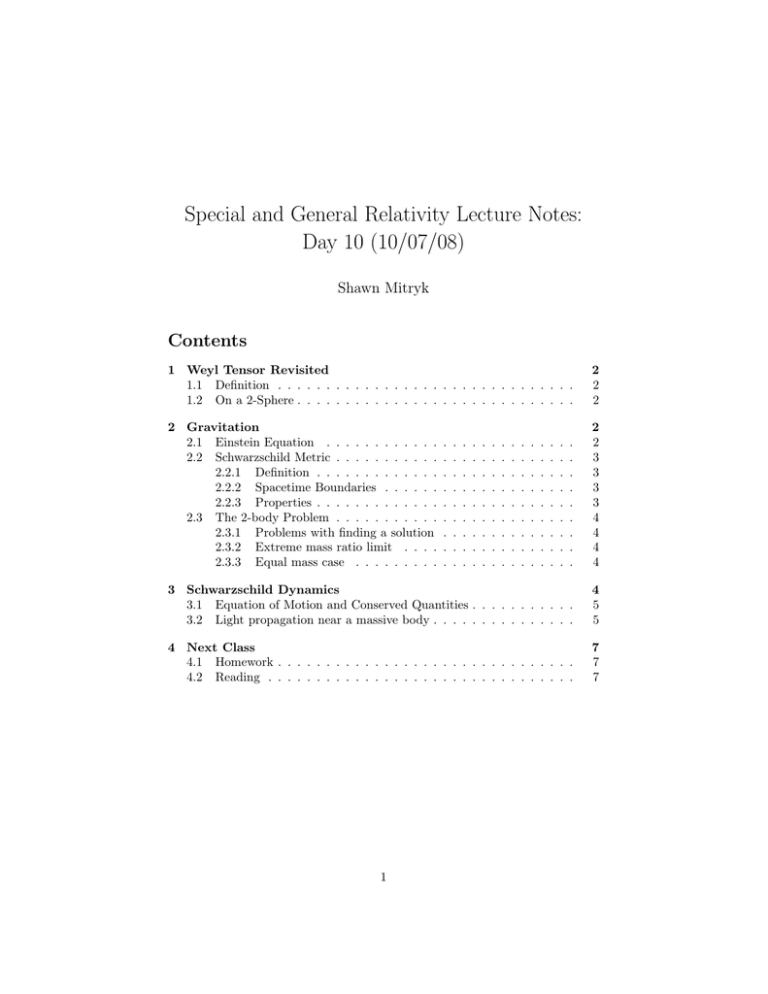
Special and General Relativity Lecture Notes: Day 10 (10/07/08) Shawn Mitryk Contents 1 Weyl Tensor Revisited 1.1 Definition . . . . . . . . . . . . . . . . . . . . . . . . . . . . . . . 1.2 On a 2-Sphere . . . . . . . . . . . . . . . . . . . . . . . . . . . . . 2 2 2 2 Gravitation 2.1 Einstein Equation . . . . . . . . . . . . 2.2 Schwarzschild Metric . . . . . . . . . . . 2.2.1 Definition . . . . . . . . . . . . . 2.2.2 Spacetime Boundaries . . . . . . 2.2.3 Properties . . . . . . . . . . . . . 2.3 The 2-body Problem . . . . . . . . . . . 2.3.1 Problems with finding a solution 2.3.2 Extreme mass ratio limit . . . . 2.3.3 Equal mass case . . . . . . . . . . . . . . . . . . 2 2 3 3 3 3 4 4 4 4 3 Schwarzschild Dynamics 3.1 Equation of Motion and Conserved Quantities . . . . . . . . . . . 3.2 Light propagation near a massive body . . . . . . . . . . . . . . . 4 5 5 4 Next Class 4.1 Homework . . . . . . . . . . . . . . . . . . . . . . . . . . . . . . . 4.2 Reading . . . . . . . . . . . . . . . . . . . . . . . . . . . . . . . . 7 7 7 1 . . . . . . . . . . . . . . . . . . . . . . . . . . . . . . . . . . . . . . . . . . . . . . . . . . . . . . . . . . . . . . . . . . . . . . . . . . . . . . . . . . . . . . . . . . . . . . . . . . . . . . . . . . . . . . . . . . . . . 1 Weyl Tensor Revisited 1.1 Definition Cρσµν = Rρσµν − 2 2 [gρ[µ Rν]σ − gσ[µ Rν]ρ ] + gρ[µ gν]σ R(1) n−2 (n − 1)(n − 2) Note: • Cρσµν is trace-free: All traces = 0 ρ is conformally invariant • C[σµν] 1.2 On a 2-Sphere Coefficients: θ • Rφθφ = sin2 (θ) • Rθθ = 1 • Rφφ = sin2 (θ) For a sphere of radius ”a”: • Rθφθφ = a2 sin2 (θ) • R= 2 2 a2 (Ricci scalar [units of 1 length2 ]) Gravitation 2.1 Einstein Equation • Previously we viewed Newtonian gravity as a force • Now the geometry of spacetime will define the gravitational affect Einstein’s Equation: Gµν = 8πGN Tµν (2) ∇µ Gµν = 0 (3) = 0 (4) µ ∇ Tµν Dual effects of spacetime curvature: • Gµν =⇒(matter curves spacetime) 8πGN Tµν • 8πGN Tµν =⇒(space moves matter) Gµν 2 2.2 2.2.1 Schwarzschild Metric Definition ds2 = −c2 ∗ [1 − dr2 2GM 2 ]dt + + r2 DΩ2 rc2 [1 − 2GM ] 2 rc (5) Properties: • Non-trivial metric (curved spacetime) • Spherically Symmetric • Vacuum solution of Einstein Equation – Gµν = 0 – Rµν = 0, R = 0 • Non-flat (Cµνρσ ∝ M r3 ) • Cµνρσ is well-behaved at r = 2M but ”blows up” at r = 0 – Diverges as r3 as r → 0 – Diverges fast enough that you can’t pass r = 0 – r = 0 is a spacetime boundary 2.2.2 Spacetime Boundaries • In flat spacetime, all geodesics extend to ±∞ affine parameter • In Schwarzschild spacetime, geodesics which reach r = 0 stop at that point with a finite affine parameter • With missing points we obtain geodesics which are singular 2.2.3 Properties • Vacuum Solution: Gµν = 0 ⇒ Tµν = 0 – No apparent matter but still curved spacetime – Spacetime can curve on it’s own • Schwarzschild is a ”static” spacetime – Time-independent: does not explicitly depend on ”t” • Every spherically symmetric static spacetime is Schwarzschild outside of matter • This replaces the Newtonian notion of gravitation. 3 2.3 The 2-body Problem Recall for Newtonian gravitation for a 2-body problem we can break it up into two parts: • center of mass motion • reduced mass gravitational problem in center of mass This can not be done when working with the Schwarzschild metric. The 2body problem does not have an analytic solution for the Schwarzschild metric. Note: A rotating black hole can be described by the Kerr metric. It is stationary but not static. 2.3.1 Problems with finding a solution Consider a mass ”m” rotating around a massive black hole ”M”: • Time-dependant rotation (due to gravitational radiation) • We can obtain a perturbed analytic ”solution” for a binary system for m → 0) (M 2.3.2 Extreme mass ratio limit • For Extreme mass ration perturbation solution: – This is situation exists in the center of all galaxies – Note ∇µTµνρσ = 0 ⇒ aµ(p.p.) = 0 – but Gµν 6= 8πGN Tµν(p.p.) • Close to m, the external spacetime is a small perturbation • Far from m, the mass’s affect on the spacetime of M is a small perturbation • In some overlap region we can connect these solutions to obtain a complete result. 2.3.3 Equal mass case With a significant amount of computing power the approximately equal mass case (up to about M = 4m) can be solved using numerical relativity 3 Schwarzschild Dynamics Consider aµ = o in a fixed Schwarzschild black hole spacetime: • Find departure from Newtonian Gravitation problem for massive particles – Orbit precesses 4 • Find affect on the straight flight path for light (massless particle) propagation – Light path is bent 3.1 Equation of Motion and Conserved Quantities Conserved Quantities: dt dλ dφ pφ = J = gφφ dλ dθ pθ = 0 = gθθ dλ pt = E = gtt (6) (7) (8) Lx , Ly , Lz are all conserved. Equation of Motion: −m2 3.2 = − dr 2 ( dλ ) E2 J2 + + r2 [1 − 2M [1 − 2M r ] r ] (9) Light propagation near a massive body dr 2 ) : Solving the Equation of Motion for ( dλ ( dr 2 ) dλ = E 2 − [1 − 2M J 2 ] r r2 (10) Differentiating we obtain: d2 r dλ2 J2 3M [1 − ] r3 r = (11) [ 3M r ] is the ”bending” term which would not be present in Newtonian dynamics. Different cases: • for r = ∞ the path is straight • for r = 3M the path is circular • for r < 3M the path converges to r = 0 (photon can not escape). Noting: dr dλ dφ dλ r E2 − = = J r2 J2 2M [1 − ] 2 r r (12) (13) 5 Figure 1: Bending of Light around a massive body We can solve for dr dφ : dr dφ r2 ± J = 2M r In the flat-space limit 1 r − E2 − J2 2M [1 − ] 2 r r (14) J2 r2 (15) = 0: dr dφ If we then define u = r r2 ± J = r E2 − then: du dφ Ju E = ± 1p 2 E − J 2 r2 J (16) = cos(φ) (17) J = r cos(φ) E (18) We then obtain the result: Now defining ũ = J Er and ro = − dũ dφ J E we can write: r 2M = 1 − ũ2 [1 − ũ] ro (19) Differentiating we find: d2 ũ dφ2 = −ũ[1 − Now defining ũ = uo + u1 and ε = obtain: 3M ro d2 (uo + u1 ) + (uo + u1 ) dφ2 6 3M ũ] ro (20) 1 we may expand the result to = [ε(uo + u1 )2 ] (21) Noting that uo = cos(φ) is a solution to the homogenous equation we find: d2 u1 + u1 dφ2 = cos2 (φ) (22) Which has the result: u1 = α cos(φ) + β sin(φ) + 1 + sin2 (φ) 3 (23) Thus, to first order in ε: ε ũ = (1 + εα) cos(φ) + εβ sin(φ) + (1 + sin2 (φ)) 3 (24) 2 (φo ) and β = 0. Using boundary conditions we find that α = − 1+sin 3 cosφo Thus, the final result for the deviation ∆r = r − ro : ∆r 4 = − GM 1 + sin2 (φo ) [1 − ] c2 cos(φo ) (25) Next Class 4.1 Homework • Noting that the arm-length of the LIGO detector is 4km, calculate a photon’s deviation distance from a straight line at the center of the detector. Given the values of the constants: 3 m • G = 6.67 ∗ 10−11 kg∗s 2 • rEarth = 6.378 ∗ 103 km • c = 2.99 ∗ 108 m s • MEarth = 5.97 ∗ 1024 kg We calculate: • GM c2 = 4.424 ∗ 10−3 m L/2 • φo = tan−1 ( rEarth ) = .01799o Finally: ∆r = − 4.2 GM 1 + sin2 (φo ) ] [1 − c2 cos(φo ) Reading • Finish Chapter 4 7 = 6.542 ∗ 10−10 m
